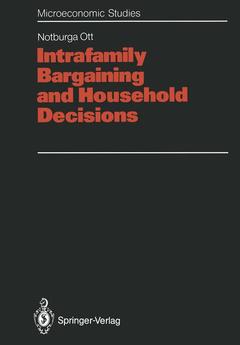Intrafamily Bargaining and Household Decisions, Softcover reprint of the original 1st ed. 1992 Coll. Microeconomic Studies
Langue : Français
Auteur : Ott Notburga

A model of household decisions based on a bargaining approach is developed providing a comprehensive framework for the analysis of family behavior. Treating the family as an economic organization, household behavior is explained by the cooperation of utility maximizing individuals. The difference to traditional microeconomic household models is that theassumption of a joint household utility function is abandoned. Instead of this, a game theoretic approach is used to model family decisions as a result of intrafamily bargaining. Considering the development of the spouses` human capital in a dynamic approach, the long-term effects of intrafamily specialization in market work and work at home are analyzed. Onemajor finding is that in a dynamic setting non-Pareto efficient allocations may result. Empirical tests demonstrate the relevanace of the bargaining approach.
1 Introduction.- 2 Models of the ‘new home economics’.- 2.1 Decisions in an existing family.- 2.2 Family formation and marital stability.- 2.3 Problems and further questions.- 3 Family decisions as a bargaining problem.- 3.1 The family as an organization of exchange.- 3.2 Household decisions as a non-cooperative game.- 3.3 Household decisions as a cooperative game.- 4 A Nash bargaining model for household decisions.- 4.1 Comparison with traditional approaches.- 4.2 Comparative statics.- 5 Time allocation in a static bargaining model with household production.- 5.1 The model.- 5.2 Division of work within the household.- 5.3 Effects of an exogenous change in wages.- 6 A dynamic model with accumulation of human capital.- 6.1 Intrafamily division of work and accumulation of human capital.- 6.2 The dynamic approach.- 6.3 Time allocation depending on individual bargaining power.- 7 Pareto efficiency of family decisions.- 7.1 Binding force of contracts and efficiency.- 7.2 Discrete choices.- 7.3 Fertility as a prisoner’s dilemma.- 8 The binding force of intrafamily contracts.- 8.1 Self-enforcing contracts.- 8.2 Enforcement by institutions.- 8.3 Remarks on policy options.- 9 Introducing uncertainty: the possibility of conflict.- 9.1 Exogenous probability of conflict.- 9.2 Causes of conflict and negotiation strategies.- 9.3 Endogenous probability of conflict.- 10 Empirical tests of the bargaining approach.- 10.1 Tests based on the Slutsky restrictions.- 10.2 Test of Pareto efficiency.- 11 Survey of empirical bargaining models.- 11.1 Household labor supply: a model with fixed bargaining power.- 11.2 Household labor supply: a game theoretic model in a discrete choice setting.- 11.3 The distribution of welfare in the household: measuring the bargaining power.- 11.4 Marriageand divorce: estimates with explicit threat point.- 12 Empirical evidence of the bargaining approach - first findings with German data.- 12.1 Balance of power within marriages.- 12.2 Fertility decision.- 12.3 Divorce behavior.- 13 Concluding remarks.
Date de parution : 02-2012
Ouvrage de 242 p.
17x24.4 cm
Thème d’Intrafamily Bargaining and Household Decisions :
© 2024 LAVOISIER S.A.S.
